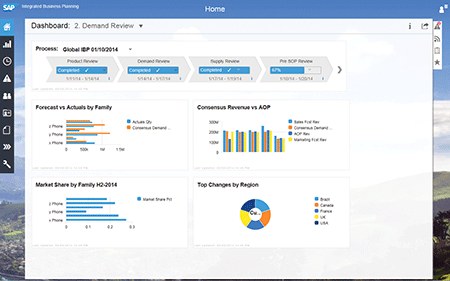Integrated Business Planning for Demand Transparency
New Cloud Solutions Enable Companies to Quickly Create and Execute Integrated Plans for Demand Networks
Earlier this year, SAP introduced its strategy for enabling companies to transform their supply chains into demand networks, where demand information is captured through new signals and fulfilled through the orchestration of a complex network of internal and external partners. This strategy is driven by the changing business realities faced by companies today. For example, demand volatility is increasing due to the rising middle class in emerging markets, aging populations in traditional markets, and the “always-on” millennial generation, which is more informed, connected, and empowered. Innovative and disruptive technologies such as 3D printing, machine-to-machine connectivity,1 and the Internet of Things are forcing companies to rethink how they set up their supply chains. And as customer expectations change,logistics networks are becoming more complex.
SAP’s supply chain strategy is centered on four main pillars:
- Supply Chain Monitoring to enable end-to-end visibility and segmentation of customers, products, and suppliers
- Integrated Business Planning to gain full demand transparency for short-, mid-, and long-term periods to subsequently drive operational demand and supply planning processes downstream for true end-to-end planning
- Demand Driven Supply Networks to gain market and customer intelligence to facilitate supply chain processes across the network
- Logistics and Order Fulfillment to align integrated distribution and fulfillment processes around speed, efficiency, and sustainability
This article focuses on the first two pillars and the SAP solutions that enable them.
Integrated Business Planning and Supply Chain Monitoring
Purchasing power and information are shifting to end consumers and customers, who increasingly demand individualized products and services delivered with a high sense of urgency. To succeed, companies require the ability to capture, interpret, plan, and quickly act on real-time information in a fast, efficient, and profitable way. Supply chains must adapt by leveraging new technology platforms that facilitate real-time decision making, provide visibility to drive predictive demand planning, and orchestrate the right response.
In July 2014, SAP launched several new cloud-based solutions that enable companies to more quickly develop, orchestrate, and execute integrated business plans with real-time information. The new SAP integrated business planning and supply chain monitoring solutions are comprised of SAP Integrated Business Planning for sales and operations, SAP Integrated Business Planning for inventory, SAP Integrated Business Planning for supply, and SAP Supply Chain Control Tower (see Figure 1). These solutions contain a collaborative environment for sales and operations planning across global functions, new optimization algorithms, and supply chain monitoring capabilities. With the speed of SAP HANA and fast adoption through SAP Cloud, they enable analysis and alerts of real-time information across the end-to-end supply and demand network.
Transforming from a supply chain to a demand network requires end-to-end visibility and segmentation of customers, products, and suppliers. Think of SAP Supply Chain Control Tower as the overarching supply chain view with big data analytics as its primary engine to drive the acquisition, cleansing, and harmonization of data from the entire demand network in real time. The control tower not only monitors current activity, but also provides an environment for the what-if simulations and predictive analytics required by supply chain professionals.
Aligning supply and demand is crucial to success, and a collaborative network not only facilitates the open exchange of data for sales and operations planning, but also drives enhanced communication among all of the stakeholders involved. This is especially important given the diminishing boundaries between supply chain professionals and other areas of the business such as finance, marketing, or sales. Supply chain professionals must have a clear understanding of the market situation, end-to-end visibility, and access to analytics and simulation capabilities. SAP Integrated Business Planning for sales and operations allows users to analyze the impact of different supply and demand scenarios, without the need to jump between systems (see Figure 2).
SAP Integrated Business Planning for sales and operations utilizes a heuristic approach to create a feasible rough-cut capacity plan. As an alternative, customers can use SAP Integrated Business Planning for supply, which can determine the optimal plan from either a lowest cost or a maximum profitability standpoint.
To ensure that the agreed-upon plan is enacted, certain key output parameters from the plan, such as inventory, are fed to the operational systems. SAP Integrated Business Planning for inventory translates demand and supply plans into specific inventory targets for every item at every location for each time period in the future planning horizon. These inventory targets are then updated in the operational systems, thereby connecting the sales and operations plan to the execution processes.
Drive Tangible Business Value
The new solutions enable companies to transform their supply chains into demand networks by:
- Simplifying and coordinating the planning experience for users across functions through a new user interface with embedded collaboration technology and the option for planners to work within Microsoft Excel
- Reacting more quickly to changes in demand to capture more sales by leveraging SAP HANA to provide demand networks with real-time monitoring and a focus on short-term planning
- Enabling more frequent planning cycles by avoiding any latency due to data transfer between different planning systems
- Ensuring plans are executed in operational systems by incorporating predictive analytics (for example, demand sensing) algorithms in combination with optimization (for example, multi-echelon inventory optimization) to translate plans into operational systems
- Reducing complexity and time to achieve business value through deployment in SAP Cloud
Future Development
Two additional modules are planned for development: SAP Integrated Business Planning for demand and SAP Integrated Business Planning for response. These will round out the integrated business planning solution set, enabling companies to plan end-to-end processes on a common, real-time SAP HANA platform. Leveraging the SAP Cloud platform, new versions of the solutions can be developed and released faster than is traditionally possible with on-premise solutions. For more details, visit www.sap.com/scm and www.sapscm-webcasts.com.
1 For more details, see “How Will the 4th Industrial Revolution Affect Your Business?” by Mike Lackey in the July-September 2014 issue of SAPinsider. [back]








